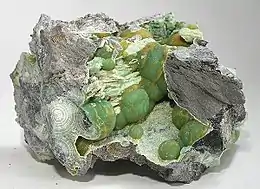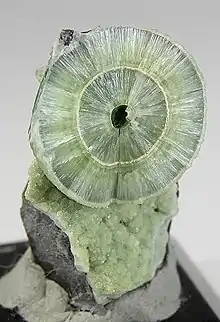| Wavellite | |
|---|---|
 Wavellite cluster from Mauldin Mountain Quarries, Mauldin Mt., Montgomery County, Arkansas | |
| General | |
| Category | Phosphate minerals |
| Formula (repeating unit) | Al3(PO4)2(OH,F)3·5H2O |
| IMA symbol | Wav[1] |
| Strunz classification | 8.DC.50 |
| Crystal system | Orthorhombic |
| Crystal class | Dipyramidal (mmm) H-M symbol: (2/m 2/m 2/m) |
| Space group | Pcmn |
| Unit cell | a = 9.621 Å b = 17.363 Å, c = 6.994 Å; Z = 4 |
| Identification | |
| Color | Green to yellowish-green and greenish blue and blue. and yellow, brown, white and colorless |
| Crystal habit | Spherical, radial aggregates; striated prisms; crusty to stalactitic |
| Cleavage | [110] perfect, [101] good, [010] distinct |
| Fracture | Uneven to subconchoidal |
| Mohs scale hardness | 3.5 - 4 |
| Luster | Vitreous to resinous, pearly |
| Streak | White |
| Diaphaneity | Translucent |
| Specific gravity | 2.36 |
| Optical properties | Biaxial (+) |
| Refractive index | nα = 1.518 - 1.535 nβ = 1.524 - 1.543 nγ = 1.544 - 1.561 |
| Birefringence | δ = 0.026 |
| Pleochroism | Weak; X = greenish; Z = yellowish |
| 2V angle | Measured: 60° to 72° |
| Fusibility | Infusable, swells and splits on heating |
| Solubility | Insoluble |
| References | [2][3][4][5] |
Wavellite is an aluminium basic phosphate mineral with formula Al3(PO4)2(OH, F)3·5H2O. Distinct crystals are rare, and it normally occurs as translucent green radial or spherical clusters.[6]
Discovery and occurrence

Wavellite was first described in 1805 for an occurrence at High Down, Filleigh, Devon, England and named by William Babington in 1805 in honor of Dr. William Wavell (1750–1829),[4] a Devon-based physician, botanist, historian, and naturalist, who brought the mineral to the attention of fellow mineralogists.[7][4][6][8]
It occurs in association with crandallite and variscite in fractures in aluminous metamorphic rock, in hydrothermal regions and in phosphate rock deposits.[2] It is found in a wide variety of locations notably in the Mount Ida, Arkansas area in the Ouachita Mountains.
It is sometimes used as a gemstone.[9]
See also
- List of minerals
- Apatite, fluoro-phosphate of calcium
- Pyromorphite, chloro-phosphate of lead
- Turquoise, a hydrated phosphate of copper and aluminium
References
- ↑ Warr, L.N. (2021). "IMA–CNMNC approved mineral symbols". Mineralogical Magazine. 85 (3): 291–320. Bibcode:2021MinM...85..291W. doi:10.1180/mgm.2021.43. S2CID 235729616.
- 1 2 Handbook of Mineralogy
- ↑ Webmineral
- 1 2 3 Mindat
- ↑ Klein, Corneis and Cornelius S. Hurlbut, Jr., Manual of Mineralogy, Wiley, 20th ed. 1985, p. 362-3 ISBN 0-471-80580-7
- 1 2 Chisholm, Hugh, ed. (1911). . Encyclopædia Britannica. Vol. 28 (11th ed.). Cambridge University Press. p. 430.
- ↑ Green, David; Cotterell, Tom; Jones, I.; Cox, D.; Cleevely, R. (2007). "Wavellite: its discovery and occurrences in the British Isles". UK Journal of Mines and Minerals. 28: 11–30.
- ↑ Curtis, Samuel and Hooker, William Jackson (1827). Memoirs of the Life and Writing of the Late Mr. William Curtis, Curtis's Botanical Magazine; or Flower Garden Displayed, v. 1 (new series), v-xxxii.
- ↑ Gemstones: Properties, identification and use by Arthur Thomas, p. 132.
External links
- "Wavellite at museum of Barnstaple and North Devon". Retrieved 9 May 2020.